Do you have a question about the Panasonic AG-HPX300 and is the answer not in the manual?
Describes the available recording modes and system formats supported by the camera.
Details on connecting power sources and mounting external accessories.
Explains the audio input connectors, switches, and controls.
Details the audio output connectors, monitoring, and volume controls.
Covers essential controls for shooting, recording, and playback operations.
Describes how to navigate and operate the camera's menu system.
Details the setup and usage of the built-in time code generator.
Explains the various lamps and indicators for system status.
Details the information displayed in the camera's windows.
Operation and features of the camera's LCD monitor.
Operation and features of the camera's viewfinder.
Information on inserting, removing, and handling P2 cards.
Procedures for transferring and managing data on P2 cards.
Fundamental steps for setting up and operating the camera for shooting.
Details on standard recording methods and formats.
Function to capture video and audio before recording starts.
Enables continuous recording by switching P2 cards and overwriting data.
Records video at specified intervals, from one frame to longer durations.
Allows immediate playback of recently recorded video segments.
Explains standard and variable speed playback options.
Adds time-coded text annotations to clips for easier reference.
Adds marks to clip thumbnails to distinguish specific clips.
Overview of available recording modes and their settings.
Selecting system frequency, recording formats, and input signals.
Procedures for manually adjusting white and black balance for optimal image quality.
Configuration of shutter speeds, including fixed and synchro-scan modes.
Customizing the functionality of user-assignable buttons.
Configuring audio sources and adjusting input signal levels.
Setting time codes, user bits, date, and time for metadata.
Explanation of indicators and messages shown on the viewfinder.
Procedures for adjusting brightness, contrast, and color of the LCD monitor.
Configuring signals for VIDEO OUT and MON OUT connectors.
Managing internal data, scene files, lens files, and SD card operations.
Writing and reading user-defined settings to/from internal memory.
Writing, reading, and resetting scene files for quick setup reproduction.
Function to correct registration errors caused by lens chromatic aberration.
Details on connecting and managing battery packs and external DC power.
Procedures for mounting lenses and performing critical calibration adjustments.
Steps to connect external microphones and wireless receivers.
Instructions for securely mounting the camera onto a tripod.
Procedure for attaching the camera's shoulder strap.
Instructions for attaching the protective rain cover.
Details on connecting and using the optional remote control unit.
Procedure for attaching an accessory knob for audio level control.
Connecting external switches for REC start/stop and tally lamps.
Overview of clip management operations using thumbnails.
Description of the thumbnail display interface and its elements.
How to select individual or multiple clips from the thumbnail screen.
Procedure for playing back selected clips from the thumbnail screen.
Filtering the thumbnail display based on criteria like format or marks.
Adding shot marks to clip thumbnails for identification.
Adding text memos to clips for annotation.
Steps for removing clips from the P2 or SD card.
Procedure to restore clips that may have become defective.
Rejoining clips that were split across multiple P2 cards.
Copying clips to P2 cards or SD memory cards.
Managing clip metadata, including user names and shooting information.
Configuring proxy recording settings with an optional video encoder card.
Procedure for formatting P2 cards to prepare them for use.
Procedure for formatting SD memory cards for use with the camera.
Customizing the display of thumbnails, including indicators and size.
Viewing and editing detailed clip information and metadata.
Connecting to external devices using the IEEE1394 (DV) cable.
Connecting the camera to a PC or HDD via USB 2.0 for data transfer.
Connecting to devices via SDI input using an optional extension board.
Essential checks to ensure the camera system is operating correctly before shooting.
Procedures for cleaning and replacing components.
Understanding and responding to system warnings and error messages.
Overview of the camera's menu structure and access methods.
Detailed steps on how to navigate and change settings within the menu.
Procedure for customizing and adding options to the USER MENU.
Comprehensive reference tables for all menu items and their settings.
General operating conditions, dimensions, and weight specifications.
Technical specifications for the camera unit's components and performance.
Specifications related to the P2 card recording media.
Technical specifications for the digital video signal processing.
Technical specifications for the digital audio signal processing.
Specifications for all input and output connectors and ports.
List of compatible optional accessories for the camera system.
Describes the available recording modes and system formats supported by the camera.
Details on connecting power sources and mounting external accessories.
Explains the audio input connectors, switches, and controls.
Details the audio output connectors, monitoring, and volume controls.
Covers essential controls for shooting, recording, and playback operations.
Describes how to navigate and operate the camera's menu system.
Details the setup and usage of the built-in time code generator.
Explains the various lamps and indicators for system status.
Details the information displayed in the camera's windows.
Operation and features of the camera's LCD monitor.
Operation and features of the camera's viewfinder.
Information on inserting, removing, and handling P2 cards.
Procedures for transferring and managing data on P2 cards.
Fundamental steps for setting up and operating the camera for shooting.
Details on standard recording methods and formats.
Function to capture video and audio before recording starts.
Enables continuous recording by switching P2 cards and overwriting data.
Records video at specified intervals, from one frame to longer durations.
Allows immediate playback of recently recorded video segments.
Explains standard and variable speed playback options.
Adds time-coded text annotations to clips for easier reference.
Adds marks to clip thumbnails to distinguish specific clips.
Overview of available recording modes and their settings.
Selecting system frequency, recording formats, and input signals.
Procedures for manually adjusting white and black balance for optimal image quality.
Configuration of shutter speeds, including fixed and synchro-scan modes.
Customizing the functionality of user-assignable buttons.
Configuring audio sources and adjusting input signal levels.
Setting time codes, user bits, date, and time for metadata.
Explanation of indicators and messages shown on the viewfinder.
Procedures for adjusting brightness, contrast, and color of the LCD monitor.
Configuring signals for VIDEO OUT and MON OUT connectors.
Managing internal data, scene files, lens files, and SD card operations.
Writing and reading user-defined settings to/from internal memory.
Writing, reading, and resetting scene files for quick setup reproduction.
Function to correct registration errors caused by lens chromatic aberration.
Details on connecting and managing battery packs and external DC power.
Procedures for mounting lenses and performing critical calibration adjustments.
Steps to connect external microphones and wireless receivers.
Instructions for securely mounting the camera onto a tripod.
Procedure for attaching the camera's shoulder strap.
Instructions for attaching the protective rain cover.
Details on connecting and using the optional remote control unit.
Procedure for attaching an accessory knob for audio level control.
Connecting external switches for REC start/stop and tally lamps.
Overview of clip management operations using thumbnails.
Description of the thumbnail display interface and its elements.
How to select individual or multiple clips from the thumbnail screen.
Procedure for playing back selected clips from the thumbnail screen.
Filtering the thumbnail display based on criteria like format or marks.
Adding shot marks to clip thumbnails for identification.
Adding text memos to clips for annotation.
Steps for removing clips from the P2 or SD card.
Procedure to restore clips that may have become defective.
Rejoining clips that were split across multiple P2 cards.
Copying clips to P2 cards or SD memory cards.
Managing clip metadata, including user names and shooting information.
Configuring proxy recording settings with an optional video encoder card.
Procedure for formatting P2 cards to prepare them for use.
Procedure for formatting SD memory cards for use with the camera.
Customizing the display of thumbnails, including indicators and size.
Viewing and editing detailed clip information and metadata.
Connecting to external devices using the IEEE1394 (DV) cable.
Connecting the camera to a PC or HDD via USB 2.0 for data transfer.
Connecting to devices via SDI input using an optional extension board.
Essential checks to ensure the camera system is operating correctly before shooting.
Procedures for cleaning and replacing components.
Understanding and responding to system warnings and error messages.
Overview of the camera's menu structure and access methods.
Detailed steps on how to navigate and change settings within the menu.
Procedure for customizing and adding options to the USER MENU.
Comprehensive reference tables for all menu items and their settings.
General operating conditions, dimensions, and weight specifications.
Technical specifications for the camera unit's components and performance.
Specifications related to the P2 card recording media.
Technical specifications for the digital video signal processing.
Technical specifications for the digital audio signal processing.
Specifications for all input and output connectors and ports.
List of compatible optional accessories for the camera system.
| Recording Format | DVCPRO HD, DVCPRO50, DVCPRO, DV |
|---|---|
| Optical Zoom | 13x |
| ND Filter | Clear, 1/4, 1/16, 1/64 |
| Media Type | P2 Card |
| Sensor Type | 3MOS |
| Video Resolution | 1920 x 1080 |
| Viewfinder | Color LCD (0.45-inch) |
| LCD Screen | 3.2-inch LCD (approx. 921, 000 pixels) |
| Audio Recording | 16-bit/48kHz |
| Audio Input | XLR x 2 |
| Audio Output | XLR |
| Video Output | HD-SDI, HDMI |
| Frame Rates | 24p, 30p, 60i |
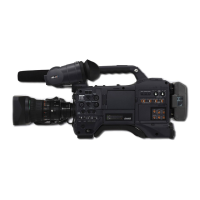
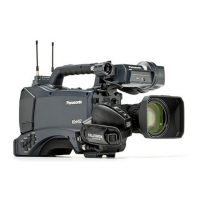

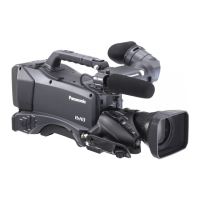

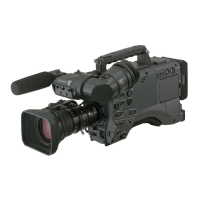
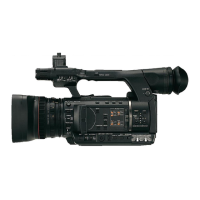
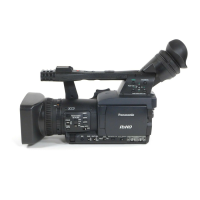

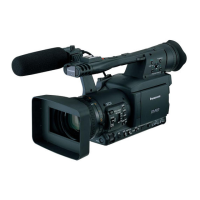
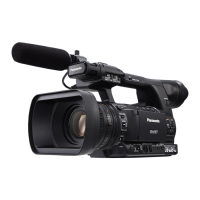

